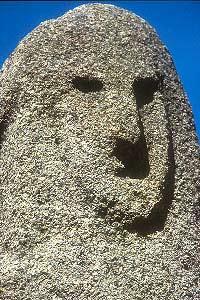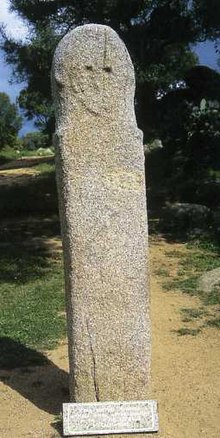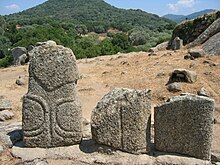Filitosa
This articleneeds additional citations forverification.(August 2014) |



Filitosais amegalithicsite in southernCorsica,France.The period of occupation spans from the end of theNeolithicera and the beginning of theBronze Age,until around theRomantimes in Corsica.
Location
[edit]
The site lies on road D57, a few hundred metres from the hamlet of Filitosa,5 kmwest ofSollacaro,in thecantonofPetreto-Bicchisano,arrondissementofSartène,[1]north ofProprianoin theCorse-du-Suddépartement.It is located on a hill, overlooking theTaravovalley.
Site history and features
[edit]The site was discovered in 1946 by the owner of the land, Charles-Antoine Cesari, and brought to the attention of archeologists by the British writer,Dorothy Carrington(see her masterpiece,Granite Island: Portrait of Corsica,[2]). Systematic excavations started in 1954 byRoger Grosjean.Finds of arrow heads and pottery date earliest inhabitation to 3300 BC. Around 1500 BC, 2-3 metremenhirswere erected. They have been carved with representations of human faces, armour and weapons.Roger Grosjeanthought the menhirs may have been erected to ward off an invasion of a group of people called theTorréens(Torreans). However this was unsuccessful: the menhirs were cast down, broken up and reused in some cases as building material by theTorréens.TheTorréensbuilt circular stone structures on the site, known astorri(ortorre), which may have been used as temples. Thetorriare remarkably well preserved. This theory had been disputed by later works of F. De Lanfranchi, M.C. Weiss andGabriel Camps.[3]
In total, about twenty menhirs of various times were counted in Filitosa. They constitute approximately half of the total staff of these monuments in Corsica.
Layout
[edit]The site of Filitosa is approached down a track through an ancientolivegrove. The first monument to be seen is a rock overhang and surrounding wall. Then the visitor comes upon the central monument. Various hut platforms are all around, and the track leads a further 50m to the Western Monument ortorri.From there, one can enjoy a view down the hill to a stone alignment of five megaliths, set around the base of a 2000-year-old olive tree. Behind the olive tree is thequarryfrom which the megaliths were extracted.
References
[edit]- ^Roger Grosjean (1961).Filitosa et son contexte archéologique dans la vallée di Taravo (Corse): recherches et fouilles 1954-1959(in French). In:Monuments et mémoires de la Fondation Eugène Piot52(1): 3-96.doi:10.3406/piot.1961.1486
- ^Dorothy Carrington (1971).Granite Island: A Portrait of CorsicaLongman, London.ISBN0-582-12630-4
- ^CORSICA Enciclopedia dell' Arte Antica (1994)(in Italian)
